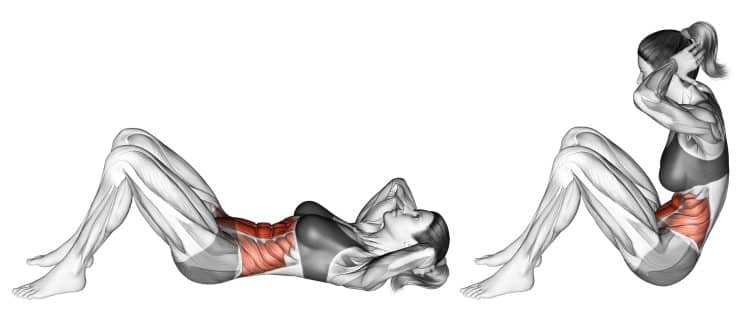Assess your core strength using our Sit-Ups Test Calculator. Uncover valuable insights, understand your results, and discover expert tips for enhancing your Sit-Up test performance.
Sit-up Test Calculator
Your Sit-ups
Population Average
How to use Sit-Up Calculator
Using the Sit-Up Calculator is a straightforward process that requires just a few simple steps.
- Select your gender
- Enter your age
- Number of repetitions you can perform
- Click on the “Calculate” button
The calculator will determine your population average, score, and rating based on your input.
Understanding Results
The Sit-Up Calculator generates three essential results:
- Population Average
- Score
- Rating
The population average represents the average number of sit-ups individuals in your age group and gender can typically perform. Your score indicates how your performance compares to the population average, while the rating categorizes your performance level, ranging from “Excellent” to “Very Poor.”
Sit-up Test Chart
The sit-up chart provides age and gender-specific benchmarks for sit-up performance. We used this same data to develop the logic for our calculator. These charts assist you in measuring and monitoring your core strength.
1-Minute Sit-up Test for Men
The following chart shows the core strength based on the number of sit-ups men can perform in a minute, categorized by different age groups.
| Age | 18-25 | 26-35 | 36-45 | 46-55 | 56-65 | 65+ |
|---|---|---|---|---|---|---|
| Excellent | >49 | >45 | >41 | >35 | >31 | >28 |
| Good | 44-49 | 40-45 | 35-41 | 29-35 | 25-31 | 22-28 |
| Above average | 39-43 | 35-39 | 30-34 | 25-28 | 21-24 | 19-21 |
| Average | 35-38 | 31-34 | 27-29 | 22-24 | 17-20 | 15-18 |
| Below Average | 31-34 | 29-30 | 23-26 | 18-21 | 13-16 | 11-14 |
| Poor | 25-30 | 22-28 | 17-22 | 13-17 | 9-12 | 7-10 |
| Very Poor | <25> | <22> | <17> | <13> | <9> | <7> |
1-Minute Sit-up Test for Women
The following chart shows the core strength based on the number of sit-ups women can perform in a minute, categorized by different age groups.
| Age | 18-25 | 26-35 | 36-45 | 46-55 | 56-65 | 65+ |
|---|---|---|---|---|---|---|
| Excellent | >43 | >39 | >33 | >27 | >24 | >23 |
| Good | 37-43 | 33-39 | 27-33 | 22-27 | 18-24 | 17-23 |
| Above average | 33-36 | 29-32 | 23-26 | 18-21 | 13-17 | 14-16 |
| Average | 29-32 | 25-28 | 19-22 | 14-17 | 10-12 | 11-13 |
| Below Average | 25-28 | 21-24 | 15-18 | 10-13 | 7-9 | 5-10 |
| Poor | 18-24 | 13-20 | 7-14 | 5-9 | 3-6 | 2-4 |
| Very Poor | <18> | <13> | <7> | <5> | <3> | <2> |
How to Perform a Sit-Up Test
To get the most accurate results from the Sit-Up Calculator, you need to ace the Sit-Up test. Here are some golden rules to follow:
Proper Form and Technique
Keep your form clean and tidy throughout the exercise. Lie flat on your back with your knees bent and feet rooted to the ground. Your arms can either be crossed over your chest or behind your head. Engage your core, lift your upper body towards your knees, then slowly glide back down to the starting position.

Testing Protocol and Scoring
The Sit-Up test needs to be conducted with care, with each repetition counted justly. A full rep means lifting your whole upper body from the ground and returning back to the starting spot. The Sit-Up Calculator uses your rep count to calculate your score and rating.
Preparing for the Test
Before diving into the Sit-Up test, warm up your body with some light aerobic exercises and dynamic stretches. This primes your muscles and gets your blood pumping. Make sure you have a comfortable and supportive surface to rest on during the test.
Related: Master the art of the sit-up to build a core so strong that it could double as a granite countertop.
Benefits of Sit-Up Tests
Sit-Up tests are more than just core strength gauges. Here are some reasons why they should be a part of your fitness arsenal:
- Building Abdominal Muscles: Sit-Ups are like laser beams, focusing mainly on your abdominal muscles, like the rectus abdominis and obliques. Regular Sit-Up tests can help sculpt and strengthen these muscles, leading to improved core stability.
- Boosting Posture and Stability: Strong abdominal muscles mean better posture and alignment. Sit-Up tests help develop a robust core, which aids stability and keeps postural imbalances at bay.
- Reducing Risk of Injury: A mighty core plays a key role in supporting and stabilizing your spine during physical activities. Regular Sit-Up tests can help you reduce the risk of lower back pain and injuries.
- Enhancing Athletic Performance: Core strength is crucial for various athletic moves, from running and jumping to rotational movements. Incorporating Sit-Up tests can help improve your athletic prowess by boosting core stability and power.
- Boosting Overall Health: Regular Sit-Up tests contribute to your overall health and fitness. A strong core supports proper body mechanics, boosts balance, and aids in functional movements in your day-to-day life.

How to Improve Your Sit-Up Test Results
If you’re aiming to enhance your Sit-Up test results, here are some strategies:
- Core Strengthening Exercises: Mix up your fitness routine with a variety of core exercises like planks, Russian twists, and bicycle crunches. Targeting different abdominal muscles can help amp up your overall core strength and stamina.
- Balanced Diet: Ensure your plate is filled with lean protein, complex carbs, and healthy fats. The right nutrition fuels your muscle growth and recovery.
- Consistent Training: Consistency is your secret weapon. Set a regular workout schedule and stick to it. Gradually step up the intensity and volume of your Sit-Up exercises over time.
- Gradual Progression: Steer clear of overexertion and possible injury by gradually increasing the number of reps or sets in your Sit-Up training. Implement the principle of progressive overload for a slow but sure improvement.
- Avoiding Common Mistakes: Keep an eye on your form and technique during Sit-Up exercises. Avoid common blunders like pulling on your neck, using momentum, or arching your lower back excessively. These can result in ineffective outcomes and possible injuries.
Conclusion
The Sit-Up Calculator is great tool to understanding and improving core strength. With it, you’ll unlock insights into your fitness, guiding your journey to a healthier, stronger you. Used correctly and consistently, along with a balanced diet and exercise regimen, you’ll see your fitness goals within reach. So, before embarking on any new exercise program, consult with a professional, and then start flexing those abs with the Sit-Up Calculator today. Your journey to improved fitness begins now!
Related:
References
- DAVIS, B. et al. (2000) Physical Education and the study of sport. 4th ed. London: Harcourt Publishers. p. 124
- Golding, et al. (1986). The Y’s way to physical fitness (3rd ed.), pages 113-124.
